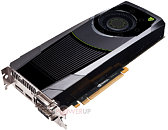Thursday, April 5th 2012

New GK104 SKU Details Surface
We know from a late-March article that NVIDIA is working on two new SKUs based on its GK104 silicon, for launch in May. With the Kepler architecture, particularly with the design of the new-generation Streaming Multiprocessors (SMX), NVIDIA substantially increased CUDA core density. Each SMX holds 192 CUDA cores, and as with the previous-generation Fermi architecture, the SMX count is the only thing NVIDIA can tinker with, to control CUDA core count in new GPUs. GeForce GTX 680's little brother, hence will have 7 out of 8 SMX units enabled, and end up with a CUDA core count of 1344. This leaves easier to configure parameters such as clock speeds, for NVIDIA to design the perfect SKU to capture a price-point. NVIDIA is targeting the sub-$399 market, while somehow maintaining competitiveness with Radeon HD 7950.Specifications of the new SKU follow.
GeForce GTX 670 Ti, by the numbers
Source:
VR-Zone
GeForce GTX 670 Ti, by the numbers
- 4 Graphics Processing Cores (GPCs), 7 Streaming Multiprocessors (SMX)
- 1344 CUDA cores
- 112 Texture Memory Units (TMUs), 32 Raster Operation Processors (ROPs)
- 256-bit wide GDDR5 memory interface
- Around 900 MHz base core clock, boost clock and feature availability not known
- Around 1250 MHz (5.00 GHz GDDR5 effective) memory clock, around 160 GB/s memory bandwidth
- Estimated price US $349-399

28 Comments on New GK104 SKU Details Surface
One would think with one power connector it would end up similar to 7850...but, and to not start a MFing flame war I will criticize both companies...nvidia does not play by the pci-e power rules (when overclocking) and AMD is making a questionable consumer decision with forced power restriction/sku differentiation choices. Whatever...that is not new to this generation and helps nvidia and hurts amd any way you look at it. That's their choice and not ours and people can make decisions accordingly.
GK106 will compete with 7870 when all is said and done, but not before nvidia releases a stop-gap gk104 to offset early 28nm yields/allocation. You may remember a similar tactic with gf100 before gf104 was released. Oh gtx465, what a POS you were. 670 should be better because the current price/performance choices are worse.
History lesson and quick note: gtx465 launched at $279 in May/June 2010, 460 at $199/229 a month and a half later in mid-July. 670 and 660ti are expected Q2 and Q3 respectively.
Although Nvidia is working from a smaller part, I don't think that means much as yield and appropriate clocks will dictate price. Nvidia won't just give them a good price to be nice, they'll balance performance to how many they can deliver. Conventional wisdom would have Nvidia looking to place an MSRP of $400, and those will dry-up faster than GTX680's, while AIB customs will get priced above that, but at least will be in the market channel relatively quick. The GTX 570 supposedly MSRP'd at $330, but face it for many months the going rate of any such customs was >$350. I'd think Nvidia knowing 7870 -$350 and 7950 - $450, they target the GTX 670 right in the middle (price/perf) , if they reduce performance to get more chips they might go to an MSRP of $380 especially if they can get a volume of chips that don't need the PCB expense of dynamic overclocking. As Nvidia receives raw wafers then determine the mix, know the problems the 28Nm part have encountered going with the past track record is not going to apply.